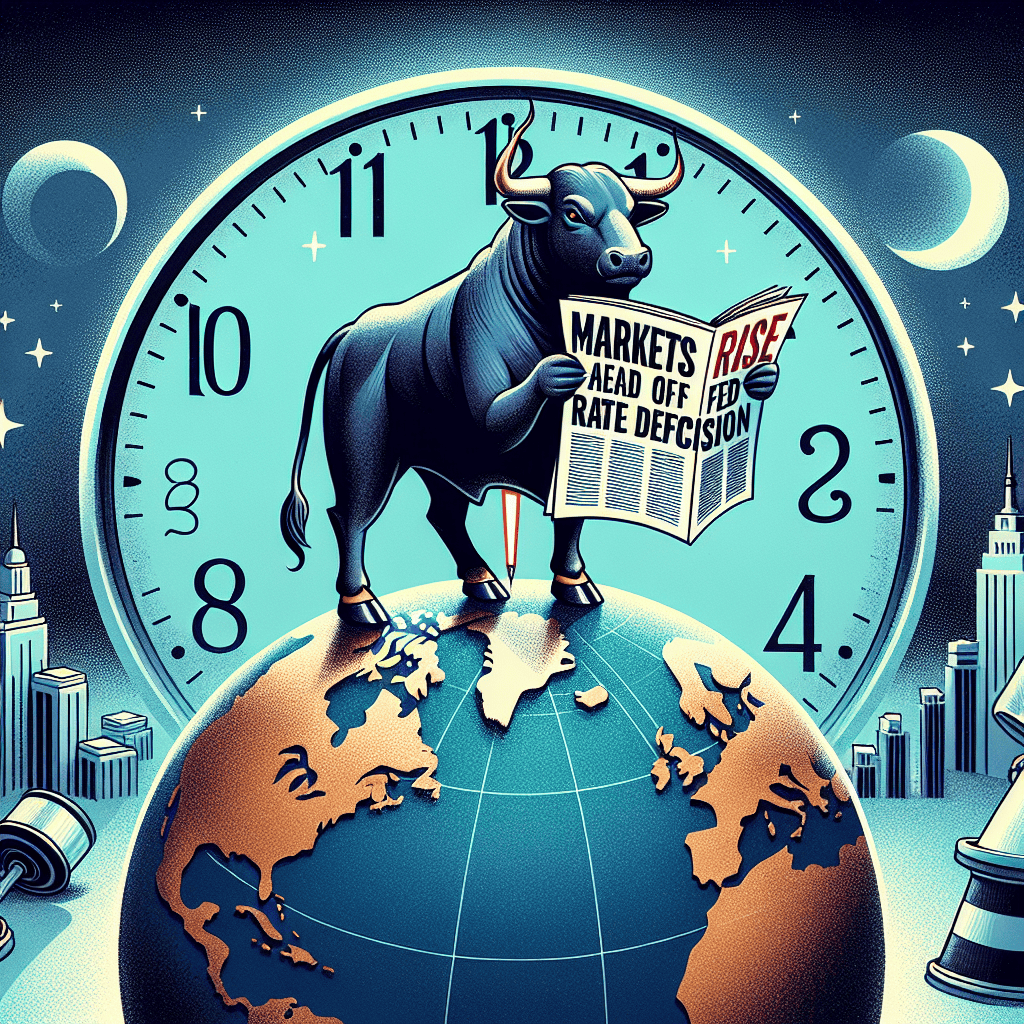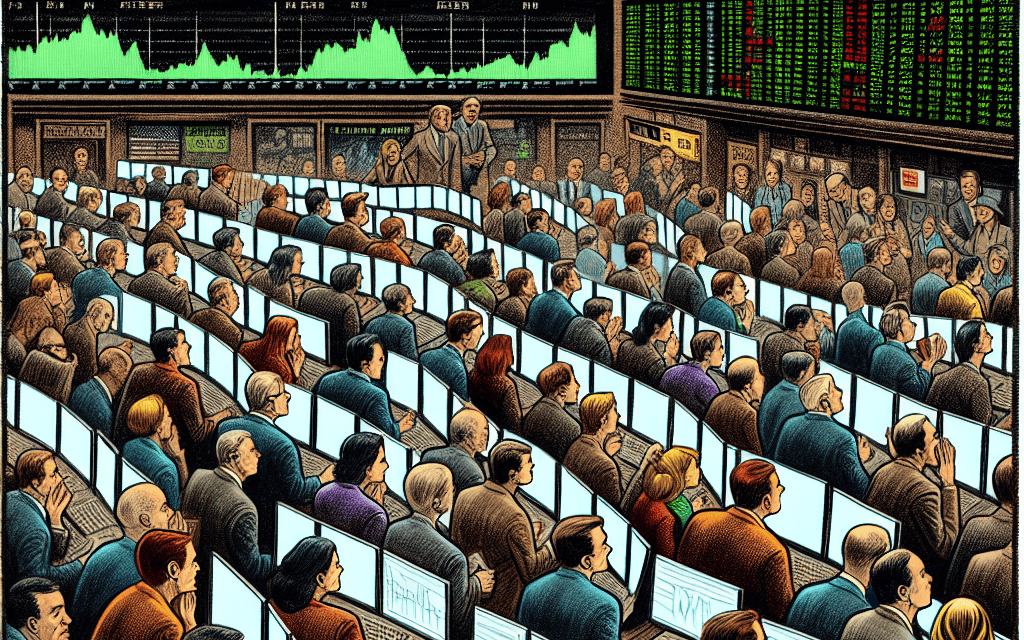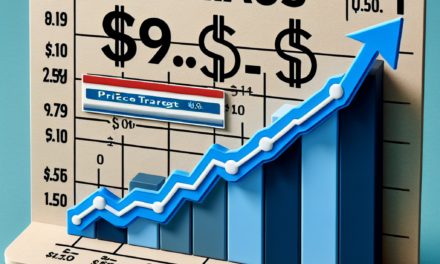“Anticipation Fuels Optimism: Markets Surge as US Elections and Fed Decision Loom”
Introduction
In the lead-up to the pivotal U.S. elections and the Federal Reserve’s impending rate decision, financial markets are experiencing a notable upswing. Investors are closely monitoring these significant events, which are poised to influence economic policy and market dynamics. The anticipation surrounding the elections, which could reshape the political landscape, coupled with the Fed’s decision on interest rates, is driving market optimism. This period of heightened activity reflects the market’s sensitivity to policy shifts and economic indicators, as stakeholders position themselves in response to potential changes in fiscal and monetary strategies.
Impact Of US Elections On Global Markets
As the United States approaches its upcoming elections, global markets are experiencing a notable rise, reflecting the anticipation and uncertainty that often accompany such significant political events. Historically, U.S. elections have had a profound impact on global markets, influencing investor sentiment and economic forecasts worldwide. This year is no exception, as market participants closely monitor the political landscape, seeking clues about future economic policies and their potential implications for international trade and investment.
The U.S. elections are particularly significant due to the country’s substantial influence on the global economy. As the world’s largest economy, changes in U.S. policy can have far-reaching effects, impacting everything from trade agreements to regulatory frameworks. Consequently, investors around the globe are keenly attuned to the electoral process, analyzing potential outcomes and adjusting their strategies accordingly. The anticipation of policy shifts, whether in taxation, regulation, or international relations, can lead to increased market volatility as investors reposition their portfolios in response to perceived risks and opportunities.
In addition to the elections, the upcoming decision by the Federal Reserve regarding interest rates is another critical factor contributing to the current market dynamics. The Federal Reserve’s monetary policy decisions are closely watched by global investors, as they can significantly influence capital flows and currency valuations. A potential rate change could alter the cost of borrowing, affecting consumer spending and business investment, both domestically and internationally. As such, the interplay between the elections and the Federal Reserve’s decision is creating a complex environment for market participants, who must weigh the potential impacts of both events on their investment strategies.
Moreover, the interconnectedness of global markets means that developments in the U.S. can have ripple effects across other economies. For instance, changes in U.S. trade policy could affect supply chains and export markets for countries around the world. Similarly, shifts in U.S. fiscal policy might influence global interest rates and capital flows, impacting emerging markets that are particularly sensitive to changes in global liquidity conditions. As a result, international investors are not only focused on the domestic implications of the U.S. elections but are also considering how these developments might affect their own economies and financial markets.
Furthermore, the current geopolitical climate adds another layer of complexity to the situation. With ongoing trade tensions and diplomatic challenges, the outcome of the U.S. elections could either exacerbate or alleviate existing global uncertainties. Investors are therefore closely monitoring political rhetoric and policy proposals, seeking to gauge the potential direction of U.S. foreign policy and its implications for international relations. This heightened level of scrutiny underscores the interconnected nature of today’s global economy, where political developments in one country can have significant repercussions for markets worldwide.
In conclusion, as the U.S. elections draw near, global markets are experiencing a period of heightened activity and anticipation. The potential for significant policy changes, coupled with the Federal Reserve’s upcoming rate decision, is creating a complex and dynamic environment for investors. As they navigate this landscape, market participants must consider not only the domestic implications of these events but also their potential impact on the broader global economy. Through careful analysis and strategic positioning, investors aim to capitalize on the opportunities and mitigate the risks associated with this pivotal moment in time.
Federal Reserve’s Rate Decision: What To Expect
As the United States approaches a pivotal moment with the upcoming elections, financial markets are experiencing a notable upswing, driven by investor anticipation and strategic positioning. This period of heightened activity is further accentuated by the Federal Reserve’s impending decision on interest rates, a critical factor that could significantly influence market dynamics. Understanding the potential outcomes of the Federal Reserve’s decision is essential for investors and policymakers alike, as it will shape economic forecasts and investment strategies in the near term.
The Federal Reserve, tasked with maintaining economic stability, faces a complex landscape as it deliberates on its next move. Inflationary pressures, labor market conditions, and global economic uncertainties are all key considerations that will inform the Fed’s decision-making process. In recent months, inflation has shown signs of moderating, yet it remains above the Fed’s target level. This persistent inflationary environment poses a challenge, as the central bank must balance the need to curb inflation with the risk of stifling economic growth.
Moreover, the labor market continues to exhibit resilience, with unemployment rates remaining low and job creation robust. This strength in employment provides the Federal Reserve with some leeway to consider rate hikes, as a strong labor market can absorb the potential negative impacts of increased borrowing costs. However, the Fed must also remain vigilant to the possibility of an overheated economy, which could necessitate more aggressive monetary tightening.
In addition to domestic factors, global economic conditions play a crucial role in shaping the Federal Reserve’s policy decisions. Geopolitical tensions, supply chain disruptions, and varying recovery rates across different regions contribute to an uncertain global economic outlook. These external factors add layers of complexity to the Fed’s decision-making process, as it must consider the potential spillover effects of its actions on the global economy.
As investors await the Federal Reserve’s announcement, market sentiment is characterized by cautious optimism. The prospect of a rate hike, while potentially dampening short-term market enthusiasm, is generally viewed as a necessary step towards ensuring long-term economic stability. Investors are keenly aware that the Fed’s actions will set the tone for financial markets, influencing everything from stock prices to bond yields and currency valuations.
In anticipation of the Fed’s decision, market participants are closely monitoring economic indicators and Fed communications for any hints of the central bank’s future policy direction. The Fed’s forward guidance will be particularly scrutinized, as it provides valuable insights into the central bank’s assessment of economic conditions and its policy trajectory. Clear and transparent communication from the Fed is crucial in managing market expectations and minimizing volatility.
Ultimately, the Federal Reserve’s rate decision will be a balancing act, weighing the need to control inflation against the imperative to support economic growth. As the Fed navigates this complex landscape, its actions will have far-reaching implications for both domestic and global markets. Investors, policymakers, and economists alike will be watching closely, as the Fed’s decision will not only influence immediate market movements but also set the stage for the broader economic outlook in the months to come. In this context, the interplay between the upcoming US elections and the Federal Reserve’s rate decision adds an additional layer of intrigue and uncertainty, making this a critical juncture for financial markets.
Historical Market Trends During Election Years
As the United States approaches another pivotal election cycle, investors and analysts alike are keenly observing historical market trends to gauge potential outcomes. Historically, election years have been characterized by heightened market volatility, driven by the uncertainty surrounding potential policy shifts and their implications for various sectors. This year is no exception, as the markets are not only contending with the electoral process but also with the impending Federal Reserve rate decision, which adds another layer of complexity to the financial landscape.
To understand the current market dynamics, it is essential to examine past election years and their impact on market behavior. Historically, the stock market has shown a tendency to perform differently depending on whether an incumbent president is running for re-election or if the election is an open race. When an incumbent is seeking another term, markets often experience a degree of stability, as investors anticipate continuity in economic policies. Conversely, open elections tend to introduce more uncertainty, as the potential for significant policy changes looms larger.
Moreover, the party affiliation of the winning candidate has also played a role in shaping market expectations. Traditionally, markets have reacted favorably to Republican victories, driven by the perception of business-friendly policies, such as tax cuts and deregulation. However, Democratic wins have not always resulted in negative market reactions, as investors often weigh the potential for increased government spending and infrastructure investment, which can stimulate economic growth.
In addition to the electoral dynamics, the Federal Reserve’s monetary policy decisions during election years have historically influenced market trends. The Fed’s role in setting interest rates is crucial, as it directly impacts borrowing costs, consumer spending, and business investment. During election years, the Fed often faces the delicate task of balancing economic stability with political neutrality. While the central bank strives to maintain its independence, its actions are inevitably scrutinized for potential political implications.
As the current election cycle unfolds, the markets are closely monitoring the Fed’s stance on interest rates. With inflationary pressures persisting and economic growth showing signs of moderation, the central bank’s decision will be pivotal in shaping investor sentiment. A rate hike could signal confidence in the economy’s resilience, but it also risks dampening growth prospects. Conversely, maintaining or cutting rates might provide a short-term boost to markets but could raise concerns about underlying economic weaknesses.
In light of these factors, investors are adopting a cautious yet opportunistic approach. Diversification remains a key strategy, as it allows investors to mitigate risks associated with political and economic uncertainties. Additionally, sectors that are less sensitive to policy changes, such as consumer staples and healthcare, are attracting increased attention. These sectors tend to exhibit resilience during periods of volatility, providing a buffer against potential market swings.
In conclusion, historical market trends during election years offer valuable insights into the potential trajectory of financial markets. While past performance is not a guarantee of future results, understanding these patterns can help investors navigate the complexities of the current environment. As the US elections and the Federal Reserve’s rate decision draw near, market participants will continue to weigh the interplay of political and economic factors, seeking to position themselves advantageously in an ever-evolving landscape.
Investor Sentiment And Market Volatility

As the United States approaches a pivotal moment with the upcoming elections and a crucial Federal Reserve rate decision, investor sentiment is experiencing a notable shift, leading to a rise in market activity. This period is characterized by a complex interplay of optimism and caution, as market participants weigh the potential outcomes of these significant events. The anticipation surrounding the elections and the Federal Reserve’s monetary policy decision has injected a fresh wave of volatility into the financial markets, prompting investors to reassess their strategies and positions.
In the weeks leading up to the elections, market participants have been closely monitoring political developments, as the results could have far-reaching implications for economic policy and regulatory frameworks. Historically, elections have been a source of uncertainty, often leading to increased market volatility. However, this year, there is a prevailing sense of optimism among investors, driven by the belief that a clear electoral outcome could provide much-needed clarity and stability. This optimism is reflected in the recent upward trend in stock indices, as investors position themselves to capitalize on potential policy shifts that could stimulate economic growth.
Simultaneously, the Federal Reserve’s upcoming rate decision is another focal point for investors. The central bank’s monetary policy has been a critical driver of market sentiment, particularly in the context of rising inflationary pressures and concerns about economic recovery. The possibility of an interest rate adjustment has led to heightened speculation, with market participants keenly analyzing economic indicators and Fed communications for any hints of future policy direction. A rate hike could signal the Fed’s confidence in the economy’s resilience, potentially boosting investor confidence. Conversely, a decision to maintain current rates might be interpreted as a cautious approach, reflecting concerns about sustaining growth amid global uncertainties.
The interplay between these two major events has created a dynamic environment where investor sentiment is continuously evolving. On one hand, the prospect of a stable political landscape and supportive monetary policy could fuel a sustained market rally. On the other hand, the inherent uncertainties associated with elections and rate decisions necessitate a degree of caution, as unexpected outcomes could trigger abrupt market reactions. Consequently, investors are employing a range of strategies to navigate this period of heightened volatility, from diversifying portfolios to hedging against potential risks.
Moreover, the global context cannot be overlooked, as international markets are also reacting to these developments. The interconnectedness of global economies means that US elections and Federal Reserve decisions have ripple effects beyond domestic borders. Investors worldwide are attuned to these events, adjusting their strategies in anticipation of potential shifts in trade policies, currency valuations, and cross-border investments. This global perspective adds another layer of complexity to the already intricate landscape of investor sentiment and market volatility.
In conclusion, as the US elections and Federal Reserve rate decision draw near, markets are experiencing a notable rise, driven by a blend of optimism and caution. Investors are navigating this period of uncertainty with a keen eye on political and economic developments, aware of the potential implications for their portfolios. The outcome of these events will undoubtedly shape the trajectory of financial markets in the coming months, underscoring the importance of staying informed and adaptable in an ever-changing investment landscape. As such, market participants remain vigilant, ready to respond to the evolving dynamics of investor sentiment and market volatility.
Key Sectors To Watch As Elections Approach
As the United States approaches a pivotal moment with the upcoming elections and a crucial Federal Reserve rate decision, market participants are keenly observing key sectors that could experience significant shifts. The interplay between political developments and monetary policy decisions is expected to create a dynamic environment for investors, with potential implications across various industries. Understanding these sectors and their potential trajectories is essential for stakeholders aiming to navigate the complexities of the current economic landscape.
Firstly, the technology sector remains a focal point for investors, given its substantial influence on the broader market. Historically, technology stocks have demonstrated resilience and growth, driven by innovation and consumer demand. However, the sector is not immune to regulatory scrutiny, which could intensify depending on the election outcomes. Policymakers may introduce new regulations affecting data privacy, antitrust issues, and digital taxation, which could impact the profitability and operational strategies of major tech companies. Consequently, investors are advised to monitor policy proposals and their potential ramifications on the technology landscape.
In addition to technology, the healthcare sector is poised for significant attention as the elections approach. Healthcare policy is a perennial topic of debate, with potential reforms influencing the sector’s future. The outcome of the elections could determine the direction of healthcare legislation, impacting areas such as drug pricing, insurance coverage, and healthcare access. Investors should consider the implications of potential policy shifts on pharmaceutical companies, insurers, and healthcare providers. Moreover, the ongoing advancements in biotechnology and telemedicine present opportunities for growth, making healthcare a sector to watch closely.
The energy sector is another critical area that could experience volatility in the lead-up to the elections and the Federal Reserve’s rate decision. Energy policies are often at the forefront of political discourse, with debates surrounding fossil fuels, renewable energy, and climate change. The election results could influence the regulatory environment for energy companies, affecting their investment strategies and operational costs. Additionally, the Federal Reserve’s rate decision may impact energy prices, as interest rates can influence the cost of capital for energy projects. Investors should remain vigilant to shifts in energy policy and monetary policy, as these factors could significantly affect the sector’s performance.
Furthermore, the financial sector is intricately linked to the Federal Reserve’s monetary policy decisions. Interest rates play a crucial role in determining the profitability of banks and financial institutions, influencing lending rates, net interest margins, and overall financial stability. As the Federal Reserve deliberates on its rate decision, investors will be closely watching for signals that could affect the financial sector’s outlook. Additionally, the elections could bring changes to financial regulations, impacting areas such as consumer protection, banking oversight, and fintech innovation. Stakeholders should consider these potential developments when evaluating investment opportunities within the financial sector.
In conclusion, as the United States approaches a critical juncture with the upcoming elections and Federal Reserve rate decision, key sectors such as technology, healthcare, energy, and finance are poised for potential shifts. Investors must remain attuned to the evolving political and economic landscape, as these factors could significantly influence market dynamics. By closely monitoring policy developments and monetary decisions, stakeholders can better position themselves to navigate the complexities of the current environment and capitalize on emerging opportunities.
How Political Uncertainty Affects Market Performance
As the United States approaches its upcoming elections, the financial markets are experiencing a notable rise, a phenomenon that often accompanies periods of political uncertainty. This trend is further compounded by the anticipation of the Federal Reserve’s impending rate decision, which adds another layer of complexity to the market dynamics. Political uncertainty, particularly in a major economy like the United States, can significantly influence market performance, as investors attempt to navigate the potential implications of electoral outcomes on economic policies and regulatory environments.
Historically, markets tend to exhibit increased volatility in the lead-up to elections. This is largely due to the unpredictability of policy changes that may follow a shift in political power. Investors, wary of potential disruptions to economic stability, often adjust their portfolios to hedge against possible risks. Consequently, this can lead to fluctuations in stock prices, bond yields, and currency values. However, it is not uncommon for markets to rise during such periods, as investors anticipate favorable policy shifts or economic stimuli that could result from a new administration.
In the current scenario, the anticipation of the Federal Reserve’s rate decision adds another dimension to market behavior. The Fed’s monetary policy plays a crucial role in shaping economic conditions, influencing everything from inflation rates to employment levels. As such, investors closely monitor any signals from the Fed regarding potential changes in interest rates. A decision to raise rates could indicate confidence in economic growth, potentially boosting market sentiment. Conversely, a decision to maintain or lower rates might suggest concerns about economic stability, prompting a more cautious approach from investors.
The interplay between political uncertainty and monetary policy decisions creates a complex environment for market participants. On one hand, the prospect of new economic policies following an election can drive optimism, as investors speculate on potential growth opportunities. On the other hand, the uncertainty surrounding these policies can lead to caution, as the actual impact on the economy remains unknown until concrete measures are implemented. This duality often results in a delicate balancing act for investors, who must weigh the potential benefits of policy changes against the inherent risks of uncertainty.
Moreover, the global nature of financial markets means that political developments in the United States can have far-reaching implications. International investors closely watch US elections, as changes in American economic policy can influence global trade dynamics, currency exchange rates, and international investment flows. Consequently, political uncertainty in the US can lead to ripple effects across global markets, further amplifying the impact on market performance.
In conclusion, the rise in markets ahead of US elections and the Federal Reserve’s rate decision underscores the intricate relationship between political uncertainty and market dynamics. While the anticipation of policy changes can drive market optimism, the inherent unpredictability of electoral outcomes necessitates a cautious approach from investors. As they navigate this complex landscape, market participants must remain vigilant, balancing the potential opportunities and risks that accompany periods of political and economic transition. Ultimately, the ability to adapt to these changing conditions will be crucial in determining market performance in the face of uncertainty.
Strategies For Investors Amid Election And Fed Uncertainty
As the United States approaches a pivotal moment with the upcoming elections and a crucial Federal Reserve rate decision, investors find themselves navigating a landscape fraught with uncertainty. The confluence of these significant events has historically led to heightened market volatility, prompting investors to reassess their strategies. In this context, understanding the potential implications of these events and adopting informed strategies becomes paramount for those looking to safeguard and potentially enhance their portfolios.
The anticipation surrounding the elections often leads to market fluctuations, as investors attempt to predict the potential policy shifts that could arise from a change in administration or congressional control. Historically, markets have shown varied reactions to election outcomes, with some sectors benefiting from specific policy agendas while others may face headwinds. For instance, a government favoring renewable energy initiatives might boost stocks in that sector, while traditional energy companies could experience pressure. Therefore, investors should consider diversifying their portfolios to mitigate risks associated with sector-specific volatility.
In tandem with the elections, the Federal Reserve’s impending rate decision adds another layer of complexity. The Fed’s monetary policy, particularly interest rate adjustments, plays a crucial role in shaping economic conditions. A rate hike could signal confidence in economic growth but might also lead to increased borrowing costs, affecting consumer spending and corporate profits. Conversely, a rate cut could stimulate economic activity but might also raise concerns about underlying economic weaknesses. Investors, therefore, need to remain vigilant and adaptable, closely monitoring economic indicators and Fed communications to anticipate potential shifts in monetary policy.
Given these uncertainties, a prudent strategy for investors is to maintain a balanced portfolio that includes a mix of asset classes. Equities, bonds, and alternative investments each respond differently to economic and political changes, providing a buffer against market volatility. Additionally, focusing on companies with strong fundamentals and resilient business models can offer stability amid turbulent times. These companies are often better positioned to weather economic fluctuations and continue delivering value to shareholders.
Moreover, investors should consider the global context, as international markets can also be influenced by US elections and Fed decisions. A diversified global portfolio can help mitigate domestic risks and capitalize on opportunities in other regions. For instance, emerging markets might offer growth potential, while developed markets could provide stability. Keeping an eye on global economic trends and geopolitical developments can further inform investment decisions.
In addition to diversification, maintaining a long-term perspective is crucial. While short-term market movements can be unsettling, history has shown that markets tend to recover and grow over time. Investors who remain focused on their long-term goals and avoid making impulsive decisions based on short-term volatility are often better positioned to achieve their financial objectives.
In conclusion, as the US elections and Federal Reserve rate decision approach, investors face a complex environment that requires careful consideration and strategic planning. By diversifying portfolios, focusing on strong fundamentals, and maintaining a global perspective, investors can navigate these uncertainties with greater confidence. Ultimately, staying informed and adaptable will be key to successfully managing investments during this period of heightened uncertainty.
Q&A
1. **What are the key factors influencing market movements ahead of the US elections?**
– Investor sentiment, potential policy changes, and economic outlook based on election outcomes.
2. **How do US elections typically impact financial markets?**
– Elections can lead to increased volatility as markets react to potential shifts in fiscal and regulatory policies.
3. **What role does the Federal Reserve’s rate decision play in market dynamics?**
– The Fed’s rate decision influences borrowing costs, consumer spending, and investment, impacting overall market performance.
4. **Why might markets rise ahead of a Federal Reserve rate decision?**
– Optimism about economic growth or expectations of favorable monetary policy can drive market gains.
5. **How do interest rate changes affect stock markets?**
– Lower rates generally boost stocks by reducing borrowing costs and encouraging investment, while higher rates can have the opposite effect.
6. **What sectors are most sensitive to changes in interest rates?**
– Financials, real estate, and utilities are typically more sensitive to interest rate changes.
7. **How do geopolitical events, like elections, interact with monetary policy in affecting markets?**
– Geopolitical events can create uncertainty, while monetary policy provides stability or stimulus, together shaping market trends.
Conclusion
In the lead-up to the US elections and the Federal Reserve’s rate decision, markets have experienced an upswing, reflecting investor optimism and anticipation. This rise can be attributed to several factors, including expectations of policy continuity or change depending on the election outcomes, and speculation about the Fed’s monetary policy direction. Investors are likely positioning themselves to capitalize on potential market movements driven by these significant events. The market’s performance during this period underscores the influence of political and economic decisions on investor sentiment and financial markets. As these events unfold, market participants will closely monitor developments to adjust their strategies accordingly.





